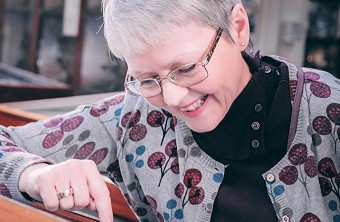
 Back to News
Back to News
11 June 2021
The Elgood Collection
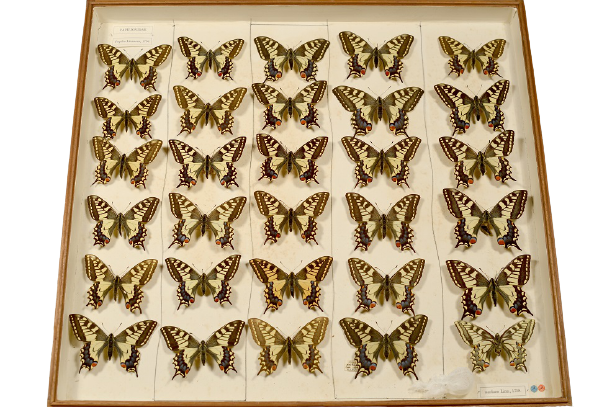
The spectacular Swallowtail Butterfly, Papilio machaon is the largest British butterfly
and now only found in Cambridgeshire and Norfolk.
The Elgood Collection holds butterfly and moth specimens from all over the UK dating from the late 1800s to the 1960s. It was created by local entomologist Walter Stewart Elgood (1902 – 1975) and is housed in large bespoke wooden cabinets in Wisbech & Fenland Museum’s stores. The collection contains thousands of specimens with examples of around 200 species.
In the past two years, it has been an inspiration to Art students from Thomas Clarkson Academy in Wisbech. It has also been explored by academics and researchers working on “Butterflies through time: Using wildlife of the past to guide conservation of the future” to engage people with the natural world and environmental change, both past and present, linking historical collections with contemporary conservation initiatives from the Zoology Museum in Cambridge.
Currently the collection is inspiring children and young people through artist workshops as part of the Schools Summer Exhibition which opens on Saturday 17 June 2021.
The Elgood Collection is an important research resource, containing many rare and extinct taxonomies. Within the collection are notable species that are now either extinct or not found in the British Isles, namely the Large Tortoiseshell and the Large Copper butterflies. Very rare is the Swallowtail butterfly and also the Large Blue butterfly the latter due to its very complicated life cycle which involves a certain species of ant to assist the embryo development. This is where climate change can play a big part in disrupting the survival of certain species. Climate instability will play a major role here in providing plant food for the caterpillar and the ant in the same area, also temperature in the ant’s nest for the chrysalis, and finally the plant providing nectar for the adult butterfly.
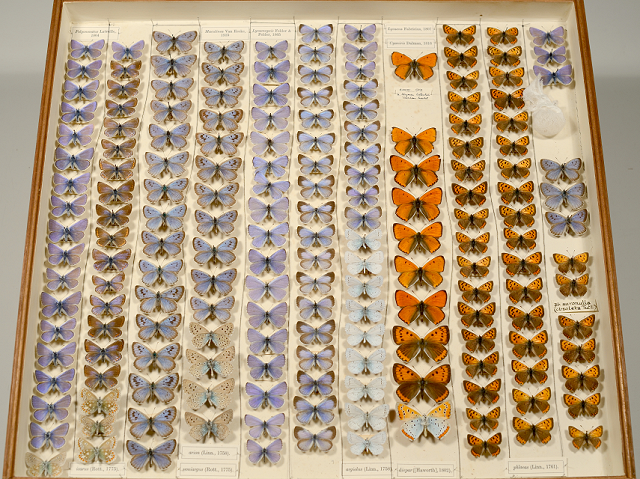
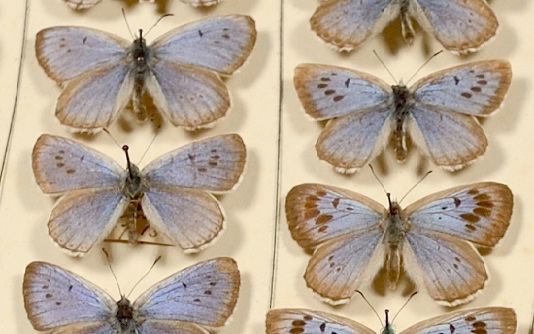

The Large Blue in columns 3 and 4 is surrounded by more common varieties
The Large Copper in Column 8 is adjacent to the Small Copper following on
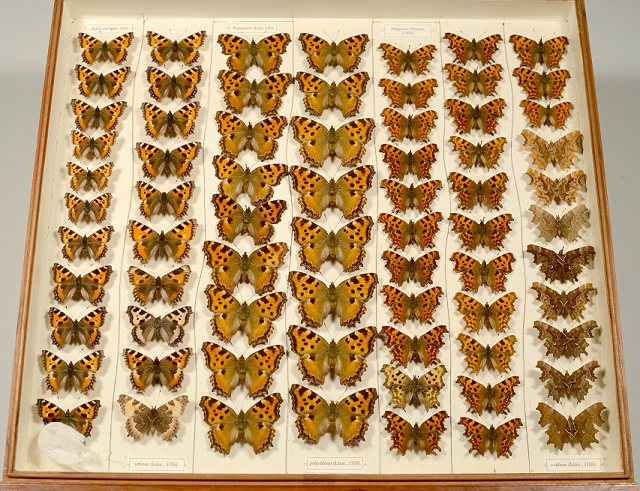
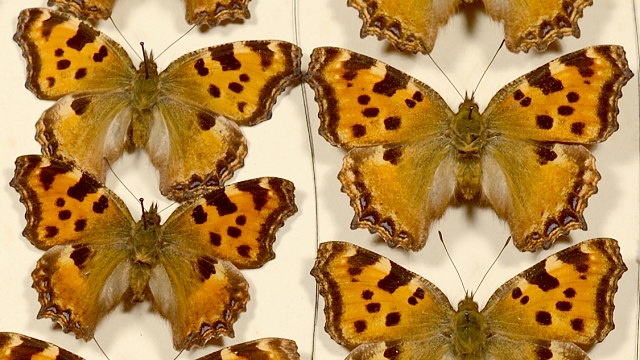
The Large Tortoiseshell butterfly (above) now not seen in the UK is shown here in columns 3 and 4.
To its left is the Small Tortoiseshell and right of it is the Common butterfly both regularly seen in most gardens
The following biography was written by Nigel Elgood and we are most grateful to him for taking the time to tell us more about collector and father, Walter Stewart Elgood.
Walter Stewart Elgood MA., C.St.J.
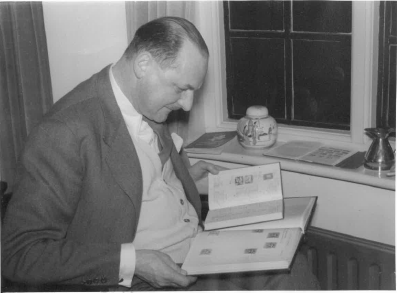
February 1956 Enjoying another of his hobbies – Philately
Walter Stewart Elgood was born in Peterborough on 18 November 1902, the only child of Thomas and Selina Elgood. He was educated at Uppingham School followed by Clare College, Cambridge where he gained a tripos degree in Sciences.
His main interest when young centred around Botany and Zoology and he specialised in Entomology and Lepidoptery. His fascination with moths and Butterflies took him all over the British Isles and his collection was built up meticulously.
He had a keen eye for detail and every insect caught and set would often take hours of patient work to get it just right. Hence the quality of his collection is second to none. It is also very comprehensive, and he again went to great lengths to capture at least one specimen of all known native species as well as migrants. A lot of this work was done in conjunction with a great friend, Sidney Pooles, who also lived in Peterborough, between 1918 and 1930. Together they caught and built up the collection and tried to catch variations of the same moth or butterfly to show different strains of the same insect. All specimens are labelled with the date and locality where caught.
Some specimens have been bred, and he again took great interest in breeding programmes, particularly with the Garden Tiger moth being involved with Mr. Sharman of Peterborough in trials to obtain an “albino” variety, and in later years with Mr. Geoff Todd of Wells-next-the-Sea, Norfolk, to establish a completely “black” form of the same moth. Examples can be seen in the collection showing that he achieved his ambition. However, it was not without incident. Two occasions come readily to mind during school holidays. There was an unused spare-room at the top of our 3-storey house which he used for breeding the Garden Tiger moths and one day my mother shouted out that there was a large caterpillar walking down the lower stair-case.
A mishap during feeding – time had allowed a lot of caterpillars to escape and unfortunately he had inadvertently left the door of the room open. We were a long time rounding up the escapees and my mother had what was referred to as “a sense of humour failure“!
We start with the more normal forms of the Garden Tiger moth followed by the extreme forms from the breeding trials. These are followed by the other varieties of the Tiger moth. We then lead into other species which show big variations in colour.

Tray of Petriburgensis – Garden Tiger Moth – normal forms and lighter forms

Extreme dark forms bred by Stewart Elgood and Geoff Todd
including a few completely black specimens unique to this collection
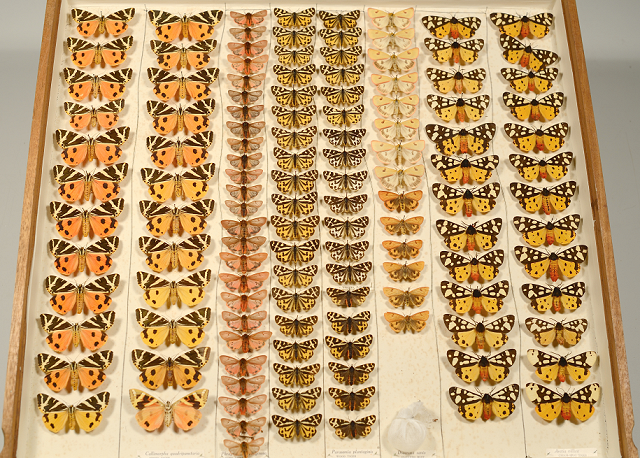
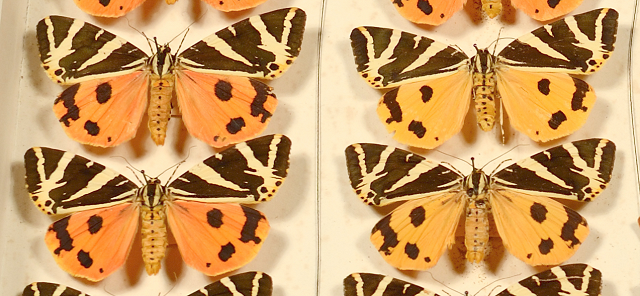
Columns 1 and 2 – Jersey Tiger

Column 3 – Ruby Tiger

Columns 4 and 5 – Wood Tiger
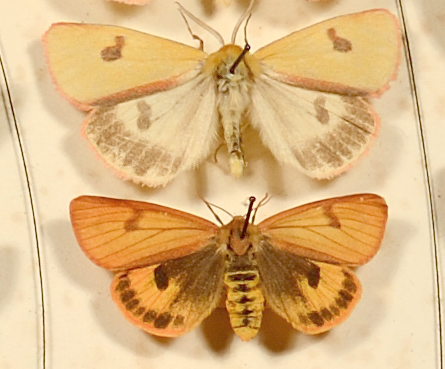
Column 6 – Clouded Buff
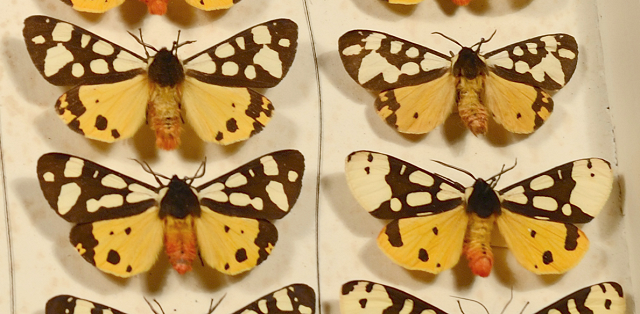
Columns 7 and 8 – Cream Spot Tiger
Other species of moth are found in their natural habitat showing a big variation in markings. Very noticeable amongst these is the Magpie moth, unusually a daytime flier but, as seen below, is found in very varied shades.
The various types of Fritillary butterfly (Nymphalidae) also show a big variation in colours amongst the species.

All forms are included in the Collection and are quite difficult to differentiate.
The other most vivid recollection involved the “Old Lady“ moth . He only had one in the collection and it had not been caught by him. So, when his old friend Sydney Pooles rang from Dorking in Surrey to say that there had been a hatching down by the river near his house he took off with no time to lose. My mother was away for a couple of days so he had to take me with him. We took the caravan as we would have to spend the night there in order to catch the moth which only flies at night. We arrived late evening to be met by Sydney by the river and the weeping willow trees where they were supposed to be. It was a cold night and there was a heavy mist over the river. Totally unsuitable conditions for any moth to fly. However, undeterred, we put the light - trap in position and then started applying the sugar mixture to the trunks of the willows. We waited and watched. Nothing!
It was as we were starting to despair that we saw it …. a moth and…. Unbelievably… a large grey one, an Old Lady. It was joined by another and several more.
There had obviously been another hatching and we couldn’t believe our luck. They were the only moths we saw that night. We eventually got to bed and I started to feel unwell and began to itch all over my body. I was tossing and turning in my bed which shook the caravan, so my father did not get any sleep. We returned to Wisbech in the morning as quickly as possible calling in at the doctor’s surgery where they diagnosed German Measles.
I have always had a close relationship with the Old Lady moth which I have recently spotted here in Wisbech. I think climate change is bringing it further North today.

The Old Lady moth is the largest moth in this drawer and is what we caught in Dorking
that evening in the Summer of 1953.
My father’s passion for collecting did not stop at moths and butterflies. He took up stamp collecting and became a keen numismatist, specialising in Great Britain and the Commonwealth.

Elgoods Brewery by Harry Jones
He left Peterborough in 1929 to come to Wisbech to work in the family Brewery with his Uncle. His interests in Wisbech included amateur dramatics and he took leading roles in the Wisbech Players’ productions in the early 1930s as well as being their Secretary and Treasurer. He enjoyed playing the piano and had the gift of being able to play pieces by ear. He took part in both Wisbech Pageants, playing the part of the Chronicler in the latter, mounted on a large grey horse. Although not a keen rider, he was interested in animals and kept many different kinds of petsand kept many different kinds, including goats, pigs, geese, chickens, ornamental ducks on the lake and a dog prior to being married. The Elgood family has always supported St. John Ambulance in Wisbech, and it was Stewart who seized the opportunity to purchase and give to the local Brigade their headquarters in William Road. He was made a Commander of the Order of St. John.
During the war he was a member of the Home Guard and also the Auxiliary Fire Service. Afterwards he was elected a member of the Town Council and served for several years. He was High Sheriff of Cambridgeshire in 1952. At heart he was a collector. He was always interested in things around him. He was passionately keen on gardening and some of his orchids still thrive. He enjoyed recording on film and often spent time tinting black and white prints to obtain the coloured effects prior to the days of colour photography. A Selection of drawers from the Collection The most striking moths found in the UK are the Hawk moths. Most of these are resident but a few are migrants flying here from Europe (Sphingidae).

The Death’s Head Hawkmoth – Resident in the UK
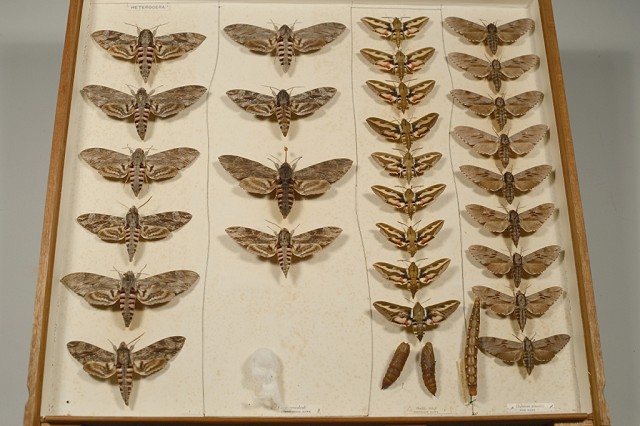
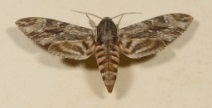
Columns 1 and 2 – Convolvulus Hawkmoth

Column 3 – Spurge Hawkmoth – Resident

Column 4 – Pine Hawkmoth – Resident


Columns 1 and 2 -Privet Hawkmoth – Resident

Column 3 – Top – Bedstraw Hawkmoth – Resident

Middle – Striped Hawkmoth

Bottom – Silver-striped Hawkmoth – very rare
This one was caught in our moth trap in the garden of our house in Old Hunstanton in the 1950s
and I recall the high level of excitement.

Column 4 – The very striking Eyed Hawkmoth – Resident.
This collection, representing a life-time hobby of collecting butterflies and moths which are to be found in the British Isles, was presented to the Wisbech Museum by the Elgood family in 1972, together with a bequest for their up-keep.
Because the mounted insects are fragile and affected by sunlight, and also by any rough handling of the drawers being opened and closed , the collection is normally stored in the basement of the Museum and only viewed by appointment with the Curator.
Taking part in the Wisbech Trade Exhibition 10 June 1953 - The Stand in the Hobbies Section
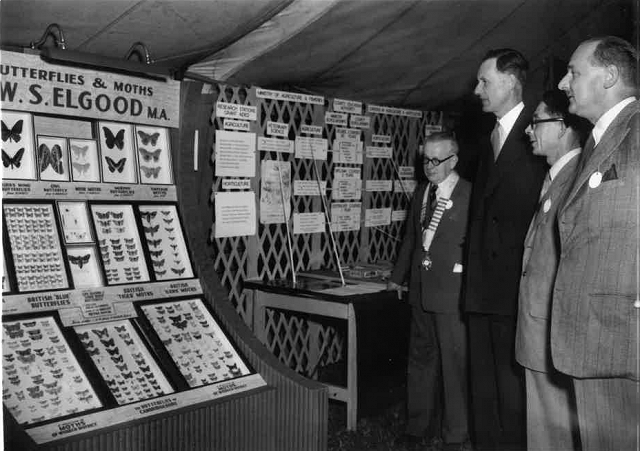
Lillian Ream ©. From left to right, President, Lord Hawke, L. Rands and W. S. Elgood.
Reproduced with permission from the Lillian Ream Trust
A few notes and explanations for budding Lepidopterists:-
In general, Butterflies fly by day and moths by night. There are exceptions to most rules and although no Butterflies fly by night, the Humming-Bird Hawk, the Silver “Y” and the Magpie are among several species of moths which are day-time fliers.
The life cycle of moths and butterflies is complex but similar. Starting at the egg which is laid on the food plant, the caterpillar hatches to feed on the leaves of the plant. When fully grown, the caterpillar will pupate and turn into the dormant form of the chrysalis. After several weeks or months, this will hatch out as the adult Moth or Butterfly which now feeds on nectar or sugar. The adults will mate with some species having hibernated over winter either in the chrysalis form or as the adult moth or butterfly, and the life cycle begins again when the eggs are laid.
Specimens in this collection have mostly been caught in “the wild”, but several have been bred from captive adults. Butterflies are usually caught with a net, whilst moths are caught at night attracted to a very bright light (normally a Mercury-Vapour Lamp for best results), or a very sweet treacle solution mixed with amyl acetate (a pungent pear drop smell) painted on to trees. The moth will sit quietly sucking at the mixture and is then able to be caught.
Alternatively, both moths and butterflies can be taken at any stage during their life cycle, since most caterpillars have distinctive markings and can normally be identified from this and the food variety. The eggs or caterpillars can be grown in captivity to emerge as the grown adult.
The collection contains very rare inter-breeding examples of the Garden Tiger moth which shows that extreme forms can be produced either without black appearing or alternatively completely black specimens can be reared.
You can find out more by visiting:
https://www.norfolkmoths.co.uk/Elgood_Collection.php
Zoology Museum:
https://museumofzoologyblog.com/
Share this article
Most recent news
 Major civil engineering business backs Wisbech Museum with cash donation
Major civil engineering business backs Wisbech Museum with cash donation
 Winners announced for 2024 Young Arts Open at Wisbech and Fenland Museum
Winners announced for 2024 Young Arts Open at Wisbech and Fenland Museum

Supporting the museum
To maintain and grow our collections we need your contributions, please support us by donating today.





